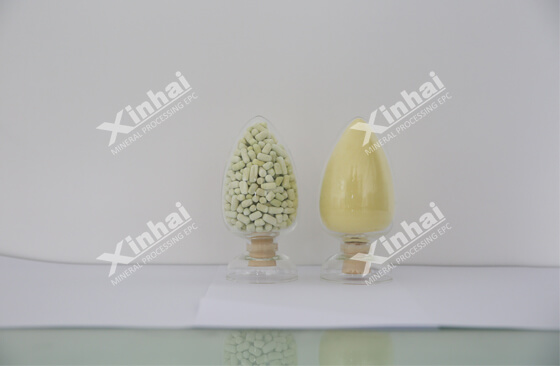

Warm Tip: If you want to know more details about equipment, solutions, etc, please click the button below for free consultation, or leave your requirements!
The associated gold and silver in polymetallic ores are important sources of gold and silver minerals. In order to improve the separation and recovery rate of associated gold and silver in polymetallic ores, it is necessary to search for collectors, regulators, and inhibitors with good selectivity to gold and silver minerals and good collection performance to facilitate multi-metal separation.
When choosing the reagent, the following 3 points should be fully considered:
Seek inhibitors that do not prevent the floatability of gold, silver minerals, and minerals such as chalcopyrite and galena, but can inhibit minerals such as sphalerite and pyrite and harmful impurities.
The non-cyanide agents used in preferential flotation include inhibitors such as lime, sodium carbonate, zinc sulfate, sodium sulfite, and sodium thiosulfate. The use of sodium carbonate in the mixed flotation is beneficial to the flotation of gold and silver sulfide ore, accelerates its flotation speed, and can reach a higher recovery rate, but it brings difficulties to separation.
The cyanide method can effectively separate galena, chalcopyrite, sphalerite, pyrite, etc., but it also has a tendency to inhibit silver ore. When the amount is large, it will dissolve gold, silver, and secondary copper minerals, causing loss and polluting the environment, should try not to use or use less.
Although lime has a good inhibitory effect on zinc and sulfur minerals, when too much lime is used, and the pH value is greater than 12, it will also inhibit silver minerals, which will reduce the recovery rate by 3-5%.
SO2 is an effective inhibitor of sphalerite, which is beneficial to the separation of galena, silver, sphalerite, and pyrite, but excessive addition will also inhibit silver minerals and galena, and its suitable pH is 6.3-6.5.
A certain mine uses sodium thiosulfate mixed with zinc sulfate in the separation of silver and copper ore, which has an obvious inhibitory effect on arsenic, zinc, and pyrite, while copper and silver are not affected, and the separation index is good.
(Sodium Thiosulfate)
Seek collectors with good selectivity to gold and silver minerals and strong collecting power.
At present, the commonly used collectors for copper, lead, and zinc includes xanthate, butyl ammonium black reagent, and aniline black medicine, all of which have the ability to collect copper, lead, and silver. But butyl xanthate has poor selectivity, which is not conducive to the next step of separation and concentrating.
A certain silver-copper mine, a certain silver-lead mine, and a certain gold mine mainly used butyl ammonium black reagent and aniline black medicine, supplemented by Z-200 and polycumene tar, reached a good selective capture and good selection indicators to copper, lead, and silver.

(Xanthate)
Select the appropriate reagent for concentrating operation.
It is used when suppressing copper and floating lead. The mixed-use of sodium cyanide and zinc sulfate has a good effect on the inhibition of secondary copper minerals, but it has a dissolving effect on gold and silver, so attention should be paid to the dosage.
It is used when suppressing lead and floating copper. When there is secondary copper, the effect of suppressing lead ore is poor.
SO2 method: SO2 does not dissolve gold and silver, has a good separation effect, wide source, and low cost, but it is difficult to control and pollute the environment.
H2SO3 method: It can control the floating of ore sludge, does not dissolve gold and silver, has very little inhibition to gold and silver, and has an activating effect on copper. The inhibition sequence is FeS2-ZnS-PbS-CuFeS2.
Sulfite (sodium bisulfite or sodium sulfite) method: relatively stable, easy to adjust, convenient to use, but high cost.
Lime ammonium chloride method: the inhibition effect on arsenic-containing minerals is obvious, and the inhibition of copper and silver mineral flotation is very small.
Besides, we also have an article about flotation reagent for gold processing and The Summary of Flotation Reagent, click to check it.
The above is the selection of reagents for gold and silver polymetallic beneficiation. In actual production, the most suitable reagents should be selected according to the composition, properties, and occurrence state of useful components of the ore itself. If necessary, the flotation reagents can be determined through beneficiation tests.
We have an article about Beneficiation of Gold-silver Polymetallic Ore, click to check it.
If you have polymetallic ore containing gold and silver to be beneficiated, we can provide you with a beneficiation test, process design, and equipment. Welcome to leave a message on our website, or consult online customer service.
Last: Beneficiation of Gold-silver Polymetallic Ore
Next: NO NEXT!
1What Are The Factors Affecting Gold Leaching?
 0
0
 5111
5111
2Common Gold Extraction Methods
 0
0
 4795
4795
3How to Choose Reagent for Gold Silver Polymetallic Ore Processing?
 0
0
 5741
5741


What Are the Differences Between CIP and CIL?
 11484
11484
 0
0